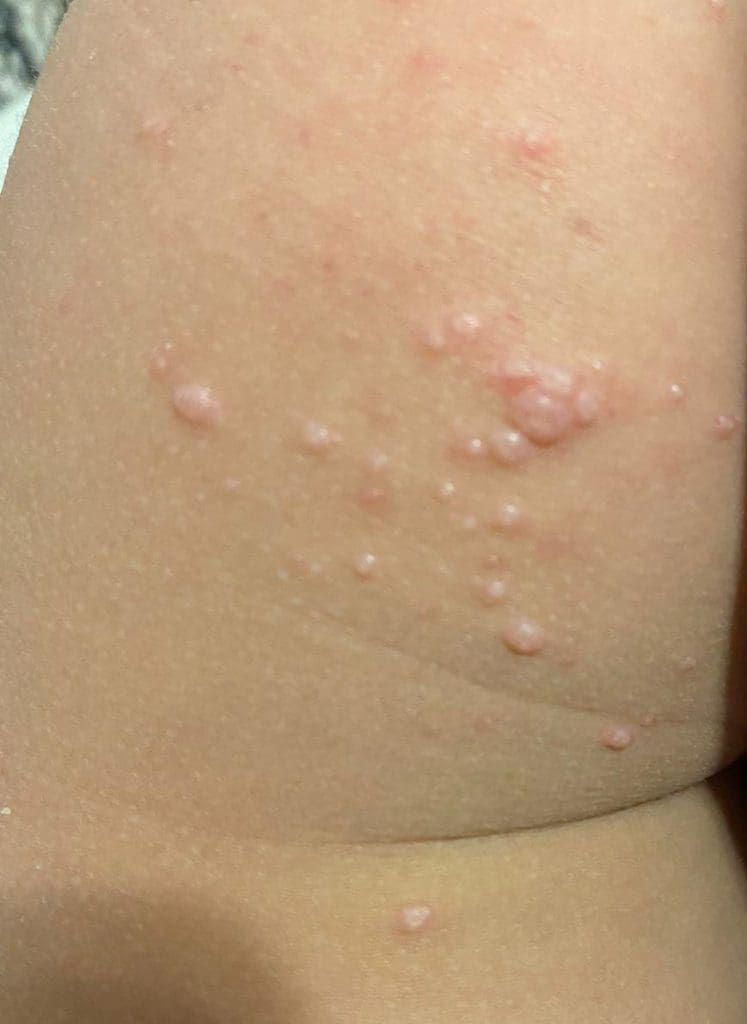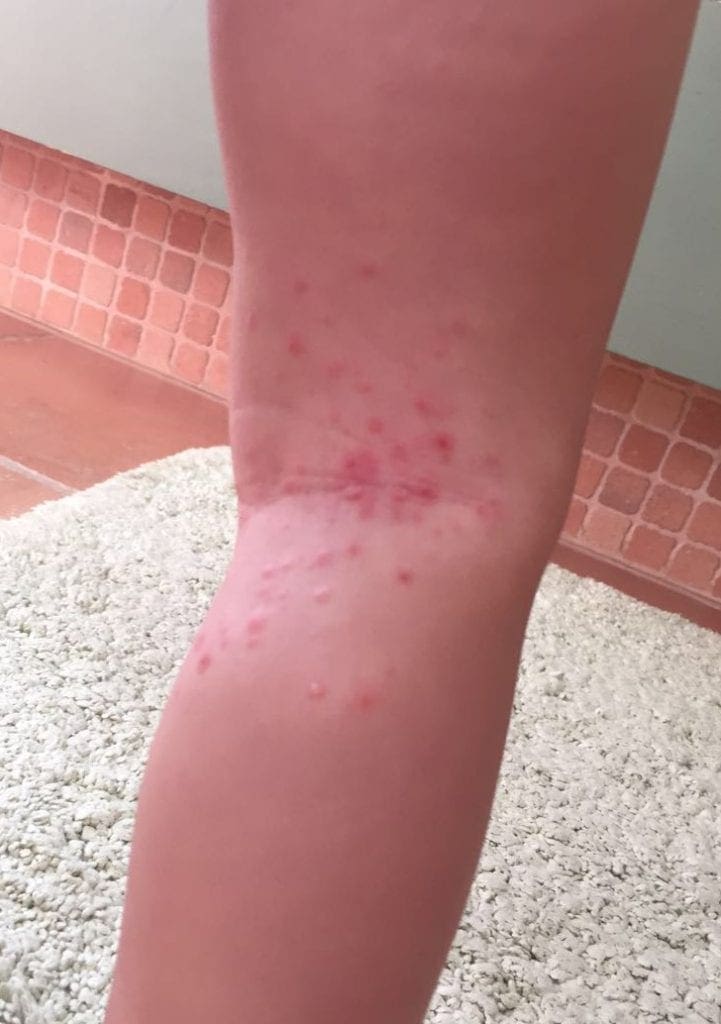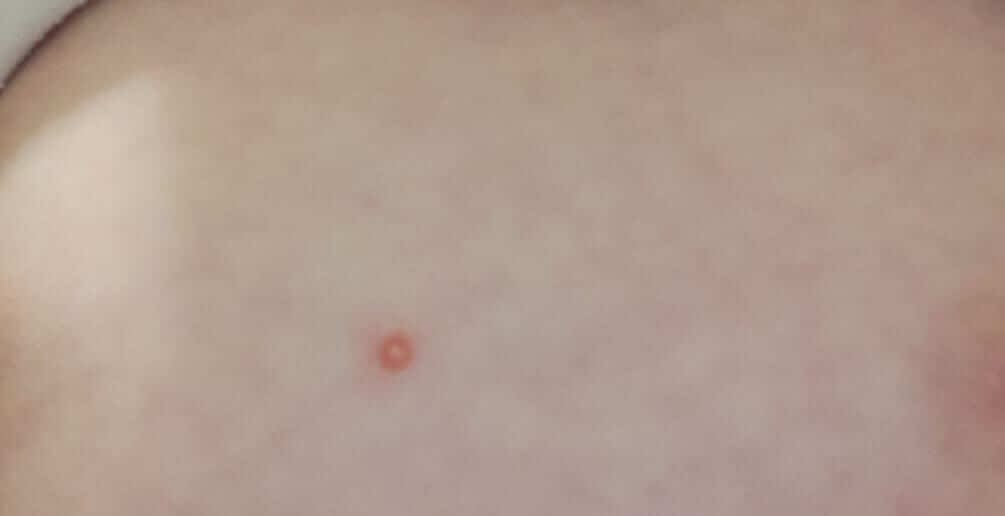
Molluscum contagiosum (viral warts)
Molluscum contagiosum is a very common viral infection in children, that causes characteristic skin lesions.
How do you identify the typical lesion? Is there a reason to worry? What is the ‘BOTE’ sign? And is there a treatment?
What is the name of the virus and its family?
The causing virus belongs to the poxvirus family. Humans are the only reservoir for this virus. Don’t be confused with the papilloma virus, that causes a different type of warts in different places.
How does a characteristic lesion of Molluscum contagiosum look like?
It is a small lesion, 1-5 mm, pearl-like white or pink colored with a central dimple. It’s normally found on the torso, face or limbs but any area of the body may be involved (except for the palms or foot soles). Sometimes there’s redness around these lesions repressing local inflammation.
How many lesions can you see in children with Molluscum contagiosum?
Ranging from one to twenty lesions, usually in proximity to one another. At times, the number of lesions is much larger.
Who is more prone to this infection?
Everyone, but:
The most common age group is children ages 2-6 years.
Children with atopic dermatitis are prone to a more widespread infection.
Children with immune suppression may suffer from a more extensive and resistant to treatment infection.
How do children get infected?
This infection is transmitted by person-to-person transmission (from an infected child to a non-infected child), by direct contact – touch, rub, scratch etc. or by contact with infected objects like towels or linen.
Once a child’s skin is infected, self-infection, also known as autoinoculation (contact with infected skin and transmission to another area), is common.
The incubation period (time from infection to appearance of lesions), is normally 2-7 weeks.

How will the doctor diagnose Molluscum contagiosum?
This is a clinical diagnosis based on the characteristic appearance of the lesions. No lab or biological swabs are required for diagnosis.
What are the complications of these viral warts in children?
The biggest problem in otherwise healthy children is first and foremost cosmetic, because the lesions may sometimes be found on exposed areas (such as face) and cause discomfort.
Second complication – itchiness and discomfort.
Third complication – a secondary bacterial infection. Bacteria that are found on our skin may infect the skin injured with molluscum. When infected, the area will look reddish, feel warm and may sometimes produce pus. See the picture or read more here.
Fourth complication – pitted scarring (see picture in this link). This rare complication happens less following a spontaneous recovery of molluscum contagiosum, with no specific treatment. In most cases, the scarring will fade away with time.
How long does it take for these lesions to disappear?
Usually, lesions disappear within 6-12 months.
Sometimes they stay for a year and a half and uncommonly even up to 4 years. Sometimes during this period old lesions disappear and new ones appear. In fact, the process of recovery is the activation of an immune response of the body against the virus. As an anecdote, in some cases after months of a static situation, an inflammatory process starts at the area of these lesions that is mistaken for a secondary infection. In fact, this is the beginning of an immune response of the body against the virus and the lesions, and the beginning of the end, referred to as ‘BOTE’ sign.
How can you prevent transmission among household members?
This is indeed infectious and it’s common to see several cases within children of the same family.
The incidence of transmission may be reduced by prevention of common baths and towels sharing.
Children with molluscum may participate in normal activities in the kindergarten or school. If the lesions are in exposed areas and especially if the child is itching or the skin is injured, it is advised to cover this area with a pad in order to pervert direct contact with the lesions.

So, if it will disappear, should we treat these warts?
We will emphasize again, that the disease always clears on its own within months/years. However, there is treatment and in some cases it’s important to treat.
What are the purposes of treatment?
– Cosmetic
– Reduction of discomfort for the child (itchiness)
– Reduction of incidence of transmission to others and self
– Prevention of complications, mainly secondary bacterial infections
Who should be considered for treatment?
Treatment should be considered in children with many lesions that cause cosmetic discomfort (many lesions on the face for example), social distress and severe irritation.
Cases with secondary bacterial infection should be treated, usually with local antibiotics.
Always remember that in healthy children, this condition is self-limiting, with or without treatment.
What is the treatment?
There’s no consensus on how to treat and there are several options. Naturally, when there’s no preferred ‘real’ medical option, then there are different approaches.
If you have decided to treat, for whatever reason, I advise to turn to a pediatric dermatologist.
The common options are:
– Cryotherapy – freezing the wart, usually using nitrogen. The treatment is not pleasant but not terrible. The Problem is, sometimes more that one treatment is required and sometimes lesions may spread beyond the area being treated (satellite lesions).
– Curettage using a special medical “spoon” to scrape the wart.
– Cantharidin – a toxin and was extracted from beetles in the past and is being manufactured synthetically today. As a response to a burn with this substance, a vesical is formed that is later shed along with the wart. This is not recommended to use on the face and in children aged two years or less. However, this is an FDA approved treatment.
In summary:
To summarize, a common condition.
My kid had over 50 lesions, all cleared without specific treatment.
In most cases, I recommend to be patient and instead of wasting time and money on unnecessary treatments, go have an ice-cream.
For comments and questions, please register
